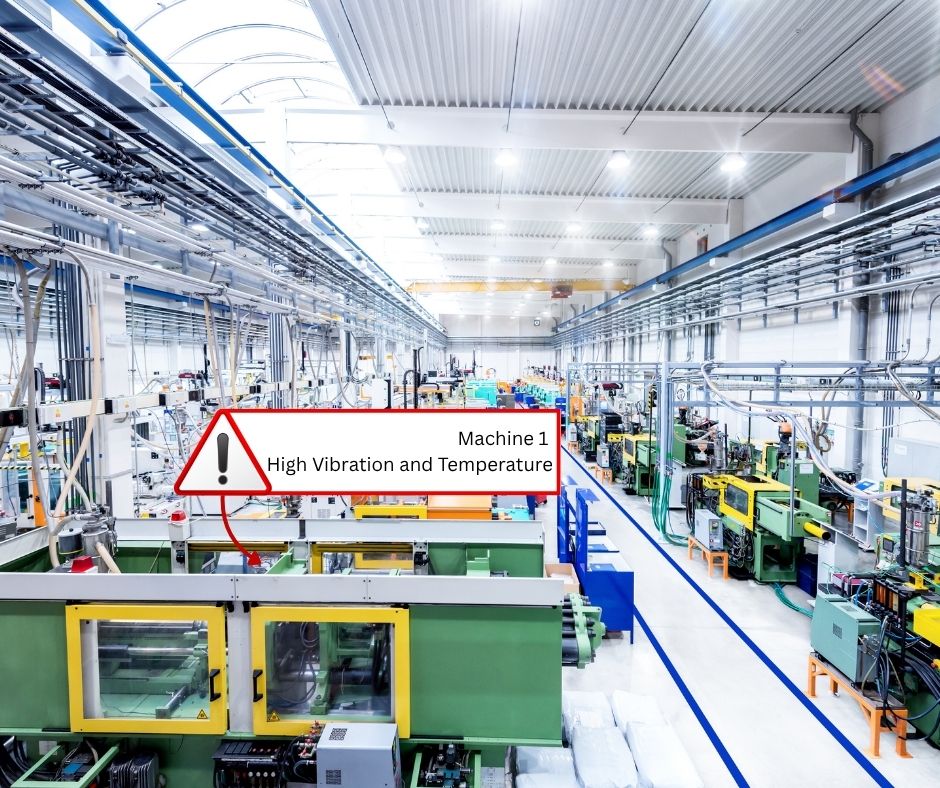5 Causes of Machine Downtime in Manufacturing and How to Prevent Them
Every manufacturing business will have experienced downtime at some point, and it can be costly, both to machinery and production. Machine downtime or breakdowns can stem from many causes. In this post, we’ll discuss five of the most typical causes and how you can stay ahead of them, fixing issues before they become major problems.
Typical Causes of Downtime
- Worn Bearings
- Overheating
- Dry Components
- Electrical Errors
- Dusty Environments
1 – Worn Bearings
Worn bearings inevitably lead to increased internal temperatures because friction rises as they degrade. Why? Bearings are designed to spin smoothly with minimal friction. As they wear down, they can become dry, or the ball bearings inside may become pitted, causing more resistance and heat generation.
Solution:
Use vibration probes to monitor bearing health. This data enables predictive maintenance, ensuring you catch wear before it causes a catastrophic failure. Although bearings will naturally wear out over time, a proper maintenance schedule will extend their lifespan and reduce unplanned downtime.
2 – Overheating
Overheating is a major issue that can lead to deformations, warping, or melting of components, resulting in costly breakdowns. Typical causes include dust buildup, poor airflow, worn bearings or motors, overloading, and high ambient temperatures.
Solution:
Install temperature probes to monitor internal machine temperatures. Pair this with automated alerts to pause machinery if it overheats.
Additionally, monitor ambient workplace temperature and consider how to distribute machine-generated heat effectively. Reusing this heat can lower energy costs in colder months.
Humidity Matters:
High humidity (above 70%) can reduce cooling efficiency, promote corrosion, and raise room temperature. Maintain humidity between 40%–60% and automate dehumidifiers or humidifiers as needed.
Lastly, worn bearings and motors also contribute to overheating. Monitor them with vibration or electrical current sensors rising readings generally signal needed maintenance.
3 – Dry Components
Any moving parts must be well-lubricated to avoid overheating and excessive vibrations, which can lead to inaccuracies (such as poor cutting or machining).
Causes of dryness include:
- General wear over time
- Extreme temperatures
- Dust buildup
- High or low humidity
- Insufficient maintenance
Solution:
Regular maintenance and lubrication are crucial. Pair environmental monitoring with maintenance scheduling to ensure all parts stay in optimal condition and extend your machinery’s lifespan.
4 – Electrical Errors
Two main types of electrical errors cause downtime:
- Internal or external cabling issues
- Humidity-related electrostatic discharge (ESD)
Cabling issues can cause incorrect voltages or shorts. If your machine is new and shows such issues, contact the supplier. For repairs, ensure they’re performed by qualified professionals using accurate diagrams and schematics.
Humidity & ESD:
Moisture from high humidity increases the risk of ESD, as water conducts electricity and can create paths for unintended discharge(sending current across the circuit causing shorting). Proper environmental monitoring helps prevent this.
5 – Dusty Environments
Dust and particulates — from materials like metal, wood, or plastic — can infiltrate machinery, clogging components and drying out parts. This leads to overheating, bearing wear, or motor blockages.
Solution:
Monitor air quality to track dust levels. Airborne dust sizes (PM1, PM2.5, PM4, and PM10) indicate how deeply particles can penetrate your machinery. Create a thorough cleaning schedule based on these measurements to keep your machines running smoothly.
Summary: How to Limit Machine Downtime
✔ Machine Monitoring
Monitoring temperature, electricity, and vibrations identifies trends and abnormalities early, avoiding costly surprises. This also improves insights into machine efficiency, running costs, carbon footprint, and productivity.
✔ Environmental Monitoring
Workplace monitoring (humidity, temperature, and air quality) ensures the environment isn’t causing downtime, while also benefiting workforce health, productivity, and compliance with sustainability regulations.
✔ Maintenance Schedules
A robust maintenance schedule keeps everything clean, lubricated, and healthy — ensuring your machines run smoothly between maintenance intervals.
✔ Predictive Maintenance
Using data from remote monitoring, predictive maintenance automates detection of issues long before they cause a breakdown. This supports a proactive maintenance plan that limits downtime and saves money.
Conclusion
Downtime is an expensive problem, but by monitoring your machines and their environment — and sticking to a strong maintenance plan — you can catch issues before they impact productivity. If you’d like help setting up a monitoring system or developing a predictive maintenance plan, we’re here to help!


